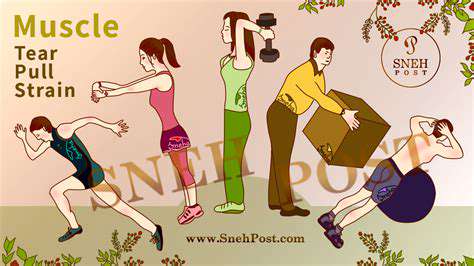The Causes of Muscle Strain and Tension

The Role of Overexertion
Overexertion is a leading cause of muscle strain and tension. When individuals push their bodies beyond their limits, they increase the risk of injury. It is vital to listen to your body and recognize when it needs a break.
Whether it's during exercise, repetitive tasks, or heavy lifting, pushing through fatigue can lead to tears in muscle fibers. These injuries may present as acute pain or soreness that lasts for a prolonged period. Understanding your personal limits and gradually increasing your activity level can help prevent these strains.
Incorporating rest and recovery into your routine is crucial. Proper warm-up and cool-down exercises can prepare your muscles for strenuous activity, reducing the risk of strain and tension significantly.
The Impact of Poor Posture
Poor posture is another significant contributor to muscle strain and tension, especially in the workplace. Slouching or sitting improperly can place undue stress on the muscles. Cultivating awareness of your posture can lead to better muscle health.
Muscles in the neck, shoulders, and lower back are particularly vulnerable. Over time, maintaining an incorrect posture can result in chronic pain and discomfort, hindering overall mobility and quality of life. Taking frequent breaks and adjusting your workspace can alleviate tension caused by poor posture.
Additionally, practicing ergonomic techniques can lead to significant improvements in muscle health. Simple changes like using a chair with proper lumbar support or adjusting your workstation height can make a world of difference.
Symptoms of Muscle Strain and Tension
Common Symptoms of Muscle Strain
Muscle strain often presents with a variety of symptoms that can vary in intensity. One of the most common signs is localized pain, which may be sharp or dull and could worsen with movement. This discomfort is typically concentrated around the affected muscle.
Additionally, swelling is frequently observed in the area of the strain. Inflammation can occur as the body responds to the injury, causing the muscle to appear puffy or feel warm to the touch.
In some cases, bruising may develop, which can indicate a more severe strain. Bruising usually occurs when small blood vessels are damaged, leading to bleeding beneath the skin.
Another symptom involves a reduced range of motion. A strained muscle may feel tight or stiff, making it difficult to stretch or use the muscle normally. This limitation can hinder daily activities and exercise.
Finally, muscle spasms are a common indicator of strain. These involuntary contractions can cause sudden, sharp pain and may occur randomly even at rest.
Recognizing Symptoms of Muscle Tension
Muscle tension is often characterized by a persistent feeling of tightness or stiffness in the affected muscles. This can lead to discomfort, especially when attempting to engage the strained muscle.
Another symptom to watch for is the experience of fatigue, which can occur as the muscles work harder to compensate for the tension. This can be particularly noticeable after physical tasks that involve the tense area.
Headaches are also commonly associated with neck and shoulder muscle tension. These are often tension-type headaches, characterized by a dull, aching sensation that can radiate to other areas of the head.
Emotional symptoms, such as increased stress or anxiety, can also be a byproduct of muscle tension. The connection between mental and physical health is strong, and elevated stress can exacerbate muscle tightness.
Finally, referred pain is a notable symptom that occurs when tension in the muscle radiates pain to other parts of the body. For instance, tension in the upper back may cause discomfort in the arms or shoulders.
Assessing the Severity of Symptoms
When evaluating muscle strain and tension, it’s vital to assess the severity of the symptoms. Mild strains may cause minor pain and swelling, allowing for self-care treatments such as resting and applying ice.
Moderate strains may lead to more significant discomfort and restricted mobility. In such cases, medical advice may be necessary to prevent further injury and recommend appropriate rehabilitation.
Severe muscle strains often involve intense pain, pronounced swelling, and significant impairment of movement. These injuries might require diagnostic imaging to rule out tears or other serious conditions.
In terms of muscle tension, assessing the duration is crucial. Acute tension from a recent injury may resolve quickly, while chronic tension might require ongoing management and professional intervention.
Finally, individuals should be aware of any accompanying symptoms, such as weakness or numbness, as these could signal a more serious underlying condition that necessitates immediate medical attention.
When to Seek Medical Attention
Knowing when to consult a medical professional is crucial for effective treatment of muscle strain and tension. If pain is severe and persists despite home care measures, it’s advisable to seek help.
Additional signs that warrant a doctor's visit include noticeable swelling or bruising that doesn’t improve after a few days, and if the affected area feels warm or tender to touch, indicating possible inflammation.
If there’s a marked decrease in the ability to move the affected muscle, or if symptoms worsen over time rather than improve, seeking medical advice is essential to prevent further complications.
Individuals who experience numbness or tingling in conjunction with muscle pain should also prioritize getting evaluated, as these symptoms could indicate nerve involvement.
Lastly, persistent muscle tension that affects daily life, including routine tasks and sleep, may require a more thorough examination and treatment plan from a healthcare provider, such as a physiotherapist or orthopedic specialist.
Effective Strategies for Relief

Understanding Muscle Strain
Muscle strain occurs when a muscle or tendon is overstretched or torn. These injuries can happen during heavy lifting, sports, or even simple movements if the body is not conditioned properly. Symptoms of muscle strain typically include pain, swelling, and reduced flexibility in the affected area.
Knowing the difference between a mild strain and a severe one is crucial. A mild strain might heal quickly with rest and home care, while a severe strain can require medical attention and possibly rehabilitation. Ignoring the signs of a muscle strain can lead to further injury and longer recovery times.
It's essential to take preventive measures by warming up before physical activities and stretching regularly. Implementing a proper conditioning program can help strengthen muscles and reduce the risk of strains.
If you do experience a muscle strain, recognizing the symptoms early can aid in quicker recovery. Resting the affected area, applying ice, and compressing the muscle can alleviate some immediate discomfort.
Effective Relief Strategies
There are numerous strategies available to help alleviate muscle strain and tension. One of the most recommended approaches is the R.I.C.E. method, which stands for Rest, Ice, Compression, and Elevation. This method is particularly useful in the initial stages following a muscle injury.
Physical therapy is another effective strategy that can aid in recovery and strengthen muscles. A professional therapist can provide personalized exercises and proper techniques to ensure muscles heal correctly and regain strength.
Heat therapy can also be beneficial in relieving muscle tension and promoting relaxation in tight muscles. It’s important to apply heat after the initial swelling has gone down to avoid aggravating the injury.
Additionally, over-the-counter pain relief medications, such as NSAIDs, can help reduce pain and inflammation. Always consult a healthcare provider before starting any medication to ensure it aligns with your health needs.